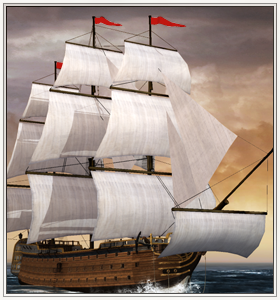Heavy First Rate (ETW Unit)
Overview
This 120-gun (or larger) “first rate” is larger than a normal ship of that class, and far more powerful than a simple count of guns would imply. The ship carries 32-, 24- and 18-pounders on its decks, and wherever possible heavier guns replace the standard cannon found on a normal first rate. The result is a very expensive, very powerful, very prestigious warship, but one that can have limited utility. Few nations can afford the expense of building and crewing such a vessel, or can operate it far from shore facilities for very long. Its sailing qualities might be charitably described as “lubberly”: this is not a ship for chasing down enemies. All these drawbacks are secondary to its massive firepower and intimidating presence: this is a ship for dashing enemies to very small pieces!
Historically, only the Santísima Trinidad, a Spanish “super battleship” of four decks and some 136 guns, ever fought in action. Constructed as a three-decker she was enormous at 120 guns, even before her reworking. She fought at Cape St Vincent (1797) and Trafalgar (1805), and foundered after the latter battle in a storm while being towed away as a prize. The American USS Pennsylvania (ordered 1821; completed 1837) never saw action, and the US Navy destroyed her in 1860 to keep her out of Confederate hands.
Details
Simply put, the massive Heavy First Rate is the slowest and most heavily armed ship available. Although they can fire devastating broadsides, and have great hull strength, heavy first rates are very easily out-maneouvered. They are also very expensive to build and maintain.
